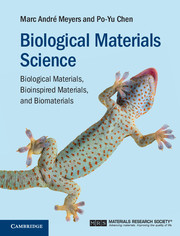Book contents
- Frontmatter
- Epigraph
- Contents
- Preface
- List of Boxes
- 1 Evolution of materials science and engineering: from natural to bioinspired materials
- Part I Basic biology principles
- Part II Biological materials
- 6 Silicate- and calcium-carbonate-based composites
- 7 Calcium-phosphate-based composites
- 8 Biological polymers and polymer composites
- 9 Biological elastomers
- 10 Biological foams (cellular solids)
- 11 Functional biological materials
- Part III Bioinspired materials and biomimetics
- References
- Index
6 - Silicate- and calcium-carbonate-based composites
from Part II - Biological materials
Published online by Cambridge University Press: 05 August 2014
- Frontmatter
- Epigraph
- Contents
- Preface
- List of Boxes
- 1 Evolution of materials science and engineering: from natural to bioinspired materials
- Part I Basic biology principles
- Part II Biological materials
- 6 Silicate- and calcium-carbonate-based composites
- 7 Calcium-phosphate-based composites
- 8 Biological polymers and polymer composites
- 9 Biological elastomers
- 10 Biological foams (cellular solids)
- 11 Functional biological materials
- Part III Bioinspired materials and biomimetics
- References
- Index
Summary
Introduction
There are numerous silicate- and calcium-carbonate-based biominerals in biological systems. Their function is, for most of them, protection. They provide a hard shell beneath which the softer organism can survive and prosper.
Exceptions are the sponges. We will provide illustrative examples and describe the structure-mechanical property relations for a few representative examples. We first cover the most important silicates and then move to shells. The number of different species is staggering: over 100 000 living species bear a shell, ranging from a single valve to eight overlapping valves. There are roughly 1000 species of mussel bivalves.
For shells, we rely here primarily on the ones studied by the UC San Diego group: abalone, conch, giant clam, and ocean and river bivalve clams. They possess quite different and unique structures, and are representative of the large number of shell species.
We also describe other carbonate-based hard materials such as the sea urchin, the smashing arm of the mantid shrimp, and the ubiquitous egg shell.
- Type
- Chapter
- Information
- Biological Materials ScienceBiological Materials, Bioinspired Materials, and Biomaterials, pp. 157 - 222Publisher: Cambridge University PressPrint publication year: 2014



